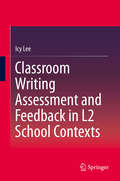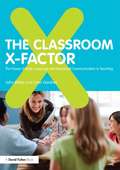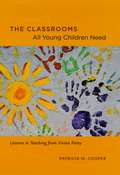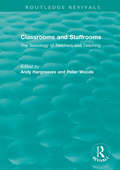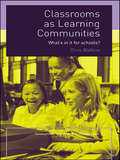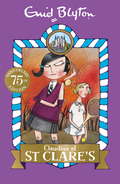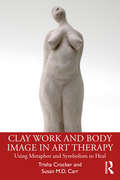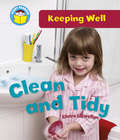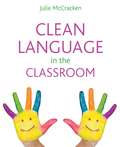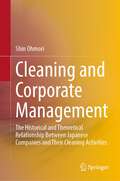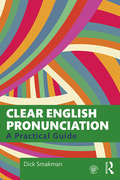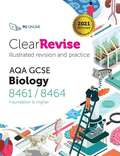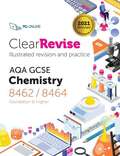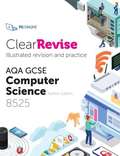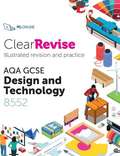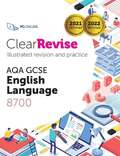- Table View
- List View
Classroom Writing Assessment and Feedback in L2 School Contexts
by Icy LeeWhile assessment and feedback tend to be treated separately in the L2 writing literature, this book brings together these two essential topics and examines how effective classroom assessment and feedback can provide a solid foundation for the successful teaching and learning of writing. Drawing upon current educational and L2 writing theories and research, the book is the first to address writing assessment and feedback in L2 primary and secondary classrooms, providing a comprehensive, up-to-date review of key issues, such as assessment for learning, assessment as learning, teacher feedback, peer feedback, portfolio assessment, and technology enhanced classroom writing assessment and feedback. The book concludes with a chapter on classroom assessment literacy for L2 writing teachers, outlines its critical components and underscores the importance of teachers undertaking continuing professional development to enhance their classroom assessment literacy. Written in an accessible style, the book provides a practical and valuable resource for L2 writing teachers to promote student writing, and for teacher educators to deliver effective classroom writing assessment and feedback training. Though the target audience is school teachers, L2 writing instructors in any context will benefit from the thorough and useful treatment of classroom assessment and feedback in the book.
The Classroom X-Factor: The Power of Body Language and Non-verbal Communication in Teaching
by John White John GardnerWhy is it that some teachers have a kind of magical charisma and charm which sets them apart from their peers? This book gives us a fresh and exciting answer – They have the classroom X-Factor! White and Gardner’s gripping text, The Classroom X Factor, examines the notion of having what the public has come to call the ‘X-Factor’ from the perspective of the teacher, offering fascinating insights into the use of non verbal communication in the classroom. Using classroom and curricular examples, this book sets out to show how both trainee and practising teachers can identify their own ‘X-Factor’ in order to help transform their perspectives and perceptions of themselves during the ‘live act’ of teaching. The book demonstrates how teachers can transform the way in which they connect with their students, whilst also creating meaningful and potent learning experiences for them. White and Gardner show that by following simple methods borrowed from psychology and cognitive science teachers can develop their own ‘X-Factor’ and in so doing increase their enjoyment and efficacy as professionals. The techniques described include some of the following: Facial and vocal expression Gesture and body language Eye contact and smiling Teacher attire, colour and the use of space Nonverbal communication and pedagogical approaches In addition, the book provides a section containing fictional stories that aim to contextualise the findings detailed throughout the text. The inclusion of chapter summaries, questions aimed at identifying the readers’ own ‘X-Factor’, lesson exemplars and a user-friendly self-evaluation framework all work together to make the book a stimulating and easy read where reflective learning and the practical application of classroom techniques are the order of the day. This comprehensive guide to developing the classroom X-Factor within you will be of value to teaching and learning and is of immense use to both practising and student teachers and to schools seeking to develop models of reflective practice. It will also be of interest to curriculum and assessment agencies, policy makers, academics and others whose roles involve the design, provision, support and evaluation of teachers’ efficacy in the classroom.
The Classroom X-Factor: The Power of Body Language and Non-verbal Communication in Teaching
by John White John GardnerWhy is it that some teachers have a kind of magical charisma and charm which sets them apart from their peers? This book gives us a fresh and exciting answer – They have the classroom X-Factor! White and Gardner’s gripping text, The Classroom X Factor, examines the notion of having what the public has come to call the ‘X-Factor’ from the perspective of the teacher, offering fascinating insights into the use of non verbal communication in the classroom. Using classroom and curricular examples, this book sets out to show how both trainee and practising teachers can identify their own ‘X-Factor’ in order to help transform their perspectives and perceptions of themselves during the ‘live act’ of teaching. The book demonstrates how teachers can transform the way in which they connect with their students, whilst also creating meaningful and potent learning experiences for them. White and Gardner show that by following simple methods borrowed from psychology and cognitive science teachers can develop their own ‘X-Factor’ and in so doing increase their enjoyment and efficacy as professionals. The techniques described include some of the following: Facial and vocal expression Gesture and body language Eye contact and smiling Teacher attire, colour and the use of space Nonverbal communication and pedagogical approaches In addition, the book provides a section containing fictional stories that aim to contextualise the findings detailed throughout the text. The inclusion of chapter summaries, questions aimed at identifying the readers’ own ‘X-Factor’, lesson exemplars and a user-friendly self-evaluation framework all work together to make the book a stimulating and easy read where reflective learning and the practical application of classroom techniques are the order of the day. This comprehensive guide to developing the classroom X-Factor within you will be of value to teaching and learning and is of immense use to both practising and student teachers and to schools seeking to develop models of reflective practice. It will also be of interest to curriculum and assessment agencies, policy makers, academics and others whose roles involve the design, provision, support and evaluation of teachers’ efficacy in the classroom.
The Classrooms All Young Children Need: Lessons in Teaching from Vivian Paley
by Patricia M. CooperTeacher and author Vivian Paley is highly regarded by parents, educators, and other professionals for her original insights into such seemingly everyday issues as play, story, gender, and how young children think. In The Classrooms All Young Children Need, Patricia M. Cooper takes a synoptic view of Paley’s many books and articles, charting the evolution of Paley’s thinking while revealing the seminal characteristics of her teaching philosophy. This careful analysis leads Cooper to identify a pedagogical model organized around two complementary principles: a curriculum that promotes play and imagination, and the idea of classrooms as fair places where young children of every color, ability, and disposition are welcome. With timely attention paid to debates about the reduction in time for play in the early childhood classroom, the role of race in education, and No Child Left Behind, The Classrooms All Young Children Need will be embraced by anyone tasked with teaching our youngest pupils.
The Classrooms All Young Children Need: Lessons in Teaching from Vivian Paley
by Patricia M. CooperTeacher and author Vivian Paley is highly regarded by parents, educators, and other professionals for her original insights into such seemingly everyday issues as play, story, gender, and how young children think. In The Classrooms All Young Children Need, Patricia M. Cooper takes a synoptic view of Paley’s many books and articles, charting the evolution of Paley’s thinking while revealing the seminal characteristics of her teaching philosophy. This careful analysis leads Cooper to identify a pedagogical model organized around two complementary principles: a curriculum that promotes play and imagination, and the idea of classrooms as fair places where young children of every color, ability, and disposition are welcome. With timely attention paid to debates about the reduction in time for play in the early childhood classroom, the role of race in education, and No Child Left Behind, The Classrooms All Young Children Need will be embraced by anyone tasked with teaching our youngest pupils.
The Classrooms All Young Children Need: Lessons in Teaching from Vivian Paley
by Patricia M. CooperTeacher and author Vivian Paley is highly regarded by parents, educators, and other professionals for her original insights into such seemingly everyday issues as play, story, gender, and how young children think. In The Classrooms All Young Children Need, Patricia M. Cooper takes a synoptic view of Paley’s many books and articles, charting the evolution of Paley’s thinking while revealing the seminal characteristics of her teaching philosophy. This careful analysis leads Cooper to identify a pedagogical model organized around two complementary principles: a curriculum that promotes play and imagination, and the idea of classrooms as fair places where young children of every color, ability, and disposition are welcome. With timely attention paid to debates about the reduction in time for play in the early childhood classroom, the role of race in education, and No Child Left Behind, The Classrooms All Young Children Need will be embraced by anyone tasked with teaching our youngest pupils.
Classrooms and Staffrooms: The Sociology of Teachers and Teaching (Routledge Revivals)
by Andy Hargreaves; Peter WoodsOriginally published in 1984, the articles presented here explore such matters as how teachers maintain order, how they treat their pupils and how they cope with pressure; they examine the ways in which teachers relate to their colleagues, what goes on in staffrooms, how they engage in educational debate, and what their ambitions are. The contributors get to grips with what it is really like to be a teacher, to make sense of the everyday rewards and penalties, opportunities and problems. This is the hallmark of the ethnographic method of educational inquiry. It brings to life (by close observation and/or in-depth interview) the internal workings of an institution or culture, revealing the perspectives of its members, their roles and adaptations and making explicit the routine or taken-for-granted features of institutional life. All the papers in the volume are to one degree or another located within this methodological tradition – they all begin with what life is actually like for teachers in schools. Though they draw on a range of theoretical perspectives, from interactionism and ethnomethodology, to Marxism and the ‘New Sociology of Education’; and more besides. In this volume the editors bring together examples of some of the most important and influential pieces of work which illustrate the range of material, and which have hitherto been spread widely among different research reports, academic journals, and collections of conference papers. Classrooms and Staffrooms provides a fund of quality source materials for initial and in-service teachers.
Classrooms and Staffrooms: The Sociology of Teachers and Teaching (Routledge Revivals)
by Andy. Hargreaves Peter WoodsOriginally published in 1984, the articles presented here explore such matters as how teachers maintain order, how they treat their pupils and how they cope with pressure; they examine the ways in which teachers relate to their colleagues, what goes on in staffrooms, how they engage in educational debate, and what their ambitions are. The contributors get to grips with what it is really like to be a teacher, to make sense of the everyday rewards and penalties, opportunities and problems. This is the hallmark of the ethnographic method of educational inquiry. It brings to life (by close observation and/or in-depth interview) the internal workings of an institution or culture, revealing the perspectives of its members, their roles and adaptations and making explicit the routine or taken-for-granted features of institutional life. All the papers in the volume are to one degree or another located within this methodological tradition – they all begin with what life is actually like for teachers in schools. Though they draw on a range of theoretical perspectives, from interactionism and ethnomethodology, to Marxism and the ‘New Sociology of Education’; and more besides. In this volume the editors bring together examples of some of the most important and influential pieces of work which illustrate the range of material, and which have hitherto been spread widely among different research reports, academic journals, and collections of conference papers. Classrooms and Staffrooms provides a fund of quality source materials for initial and in-service teachers.
Classrooms as Learning Communities: What's In It For Schools? (What's in it for schools?)
by Chris WatkinsIn classrooms that operate as learning communities, the social and learning purposes advance together through all participants being involved and engaged in building knowledge. This book demonstrates a new way of seeing and managing classrooms through: an integration of what's best in learning and what's best in the social life of classrooms a vision of the role of the teacher that is more creative and more related to the commitments of teachers a more connected view of schools in contrast to the mechanistic view that currently dominates an answer to the short-term performance pressures of politicians - better performance. The practice and vision of classrooms that operate as learning communities is presented clearly and encourages teachers to take steps towards building a more effective classroom with the aspects of learning communities they choose.
Classrooms as Learning Communities: What's In It For Schools? (What's in it for schools?)
by Chris WatkinsIn classrooms that operate as learning communities, the social and learning purposes advance together through all participants being involved and engaged in building knowledge. This book demonstrates a new way of seeing and managing classrooms through: an integration of what's best in learning and what's best in the social life of classrooms a vision of the role of the teacher that is more creative and more related to the commitments of teachers a more connected view of schools in contrast to the mechanistic view that currently dominates an answer to the short-term performance pressures of politicians - better performance. The practice and vision of classrooms that operate as learning communities is presented clearly and encourages teachers to take steps towards building a more effective classroom with the aspects of learning communities they choose.
Claudine at St Clare's: Book 7 (St Clare's #Vol. 5)
by Enid BlytonSchooldays at St Clare's are never dull for twins Pat and Isabel O'Sullivan in Enid Blyton's much-loved boarding school series.In book seven, Eileen's mother is the new Matron and Mam'zelle's niece, Claudine, joins St Clare's and causes havoc wherever she goes. The twins are enchanted by rebellious Claudine and her mad-cap plans, but will she last the term?Expect more mischief at St Clare's!Between 1941 and 1946, Enid Blyton wrote six novels set at St Clare's. This edition features the original text and is unillustrated.
Clay Work and Body Image in Art Therapy: Using Metaphor and Symbolism to Heal
by Trisha Crocker Susan M.D. CarrClay Work and Body Image in Art Therapy provides an important addition to resources available in the field of clay work and art therapy, highlighting the unique sensory aspects of the medium and its ability to provide a therapeutic resource for women who experience body image issues. Chapters offer a comprehensive distillation of current knowledge in the field of body image, clay work, neuroscience, and art therapy, building a theoretical framework around personal narratives. Case studies examine the benefits of exploring body image through clay work within art therapy practice, providing a positive and contained way to find personal acceptance and featuring photographs of clay body image sculptures created by research participants that highlight their individual stories and experiences. As well as offering both clinical and practical implications, the text provides a full protocol for the research and evaluation methods carried out, enabling further replication of the intervention and research methods by other therapists. This book highlights clay work as a significant resource for art therapists, arts in health practitioners, and counsellors, providing an emotive yet contained approach to the development of personal body image acceptance and self-compassion.
Clay Work and Body Image in Art Therapy: Using Metaphor and Symbolism to Heal
by Trisha Crocker Susan M.D. CarrClay Work and Body Image in Art Therapy provides an important addition to resources available in the field of clay work and art therapy, highlighting the unique sensory aspects of the medium and its ability to provide a therapeutic resource for women who experience body image issues. Chapters offer a comprehensive distillation of current knowledge in the field of body image, clay work, neuroscience, and art therapy, building a theoretical framework around personal narratives. Case studies examine the benefits of exploring body image through clay work within art therapy practice, providing a positive and contained way to find personal acceptance and featuring photographs of clay body image sculptures created by research participants that highlight their individual stories and experiences. As well as offering both clinical and practical implications, the text provides a full protocol for the research and evaluation methods carried out, enabling further replication of the intervention and research methods by other therapists. This book highlights clay work as a significant resource for art therapists, arts in health practitioners, and counsellors, providing an emotive yet contained approach to the development of personal body image acceptance and self-compassion.
Clean and Tidy: Keeping Well: Clean And Tidy (Start Reading: Pip's Pets #3)
by Claire LlewellynClean and Tidy looks at how to keep clean, neat and tidy, from brushing your hair to having a bath. This non-fiction series of four books is at band 3 of the Start Reading programme.
Clean Language in the Classroom
by Julie McCrackenWritten by a real teacher, who puts her ideas to practice in a real classroom, with real children; this book provides a comprehensive selection of step-by-step instructions, case studies, clean questions for SEN and examples of how to effectively introduce Clean Language practice within the classroom. It aims to improve communication and inclusion to develop a productive learning environment for students and teachers alike. It encourages children, teachers and parents to respect the others and their needs. This innovative new book gives teachers the tools on how to include effective clean questions in their lesson planning based on a mini-research project undertaken by Julie in her own classroom with her pupils to discover the benefits of using clean language in the classroom.
Cleaning: NVQ/SVQ Level 2 (PDF)
by Diane Canwell Tricia Rivers Caroline Roberts Ruth Whaites David PopeUp-to-date, tailored support to help candidates through their NVQ as quickly and easily as possible! It delivers the knowledge for the mandatory units and a range of popular option units for the NVQ and the new Technical Certificate, plus lots of help with preparation for assessment. Consistent style and layout builds candidates' confidence as they work through the text. Simple, accessible language helps to deliver the underpinning knowledge to candidates with basic skills needs, or English as a second language. Includes spaces for learners to write in order to aid evidence generation and portfolio building.
Cleaning and Corporate Management: The Historical and Theoretical Relationship Between Japanese Companies and Their Cleaning Activities
by Shin OhmoriThis book provides a new way of understanding Japanese management by focusing on the relationship between Japanese companies and their social practices. Whereas previous studies have often concentrated on the uniqueness of Japanese companies' systems (e.g., lifetime employment, the seniority system, company-specific unions) or methods (e.g., bottom-up management, Toyota production methods), this book explains the uniqueness of Japanese companies’ activities and practices. It especially highlights the day-to-day cleaning activities that many companies have practiced for numbers of years, regardless of their size or industry. Activities that continue beyond a certain period of time are called social practices, and the book clarifies how this particular social practice has historically been formed in Japanese companies and then shows what it means to keep cherishing those cleaning practices. This study consists of two parts: historical research and theoretical research. The historical research sheds light on the relationship between Japanese companies and cleaning activities from a historical point of view. On the basis of old literature and in-house documents, the reader can understand how Japanese companies have positioned cleaning practices in the process of increasing their growth potential and competitiveness and in maintaining their businesses. The second part explains theoretically the relationship between cleaning and management with quantitative and qualitative data from Japanese companies today. Using survey results from Japanese companies, the book shows what kinds of organizations will be formed and human resources will be developed if companies have been focusing for many years on 5S activities—Sort, Set in Order, Shine, Standardize, and Sustain— that include cleaning. This part of the book presents the distinctive problem-solving and strategy-creation processes of Japanese companies in contrast to the activities of European and American companies.
Clear English Pronunciation: A Practical Guide
by Dick SmakmanClear English Pronunciation provides students with the tools to effectively communicate in English without centring solely on native-speaker pronunciation models. The focus of the book is on individual pronunciation targets rather than a one-size-fits-all approach. Divided into four sections, each featuring detailed articulatory explanations, sample sentences, and recordings to help learners improve their pronunciation, this book: introduces the phenomenon of pronunciation as part of a broader communicative realm; explains and demonstrates the melody and rhythm of understandable and natural English pronunciation; supports students in identifying and practicing their own pronunciation issues. Supported by an interactive companion website which features recordings and expanded explanations of key topics, Clear English Pronunciation is an essential textbook for international learners of English who want to improve their pronunciation skills in diverse social settings. https://www.universiteitleiden.nl/clearenglishpronunciation
Clear English Pronunciation: A Practical Guide
by Dick SmakmanClear English Pronunciation provides students with the tools to effectively communicate in English without centring solely on native-speaker pronunciation models. The focus of the book is on individual pronunciation targets rather than a one-size-fits-all approach. Divided into four sections, each featuring detailed articulatory explanations, sample sentences, and recordings to help learners improve their pronunciation, this book: introduces the phenomenon of pronunciation as part of a broader communicative realm; explains and demonstrates the melody and rhythm of understandable and natural English pronunciation; supports students in identifying and practicing their own pronunciation issues. Supported by an interactive companion website which features recordings and expanded explanations of key topics, Clear English Pronunciation is an essential textbook for international learners of English who want to improve their pronunciation skills in diverse social settings. https://www.universiteitleiden.nl/clearenglishpronunciation
ClearReivise AQA GCSE Physical Education 8582
by Pg OnlineAbsolute clarity is the aim with a new generation of GCSE revision guides. This clear study guide has been expertly compiled and edited by successful teachers of PE, highly experienced examiners and a good dollop of scientific research into what makes revision most effective and more accessible. It covers each of the different optional topics. Contains over 400 marks worth of examination style questions. Answers provided for all questions within the book.
ClearRevise AQA GCSE 8461 / 8464 (PDF)
by Pg OnlineIllustrated revision and practice. Covers separate Biology and Trilogy at Foundation and Higher levels. Past examinations questions are essential to good preparation, improving understanding and confidence. This guide has combined revision with tips and more practice questions than you could shake a stick at. All the essential ingredients for getting a grade you can be really proud of.
ClearRevise AQA GCSE 8462 / 8464 (PDF)
by Pg OnlineIllustrated revision and practice. Covers separate Chemistry and Trilogy at Foundation and Higher levels. Past examinations questions are essential to good preparation, improving understanding and confidence. This guide has combined revision with tips and more practice questions than you could shake a stick at. All the essential ingredients for getting a grade you can be really proud of.
ClearRevise AQA GCSE Computer Science 8525
by Pg OnlineIllustrated revision and practice: Over 500 marks worth of examination style questions. Answers provided for all questions within the book. Specification references for every topic. Examination tips and techniques. Free Python solutions pack. Absolute clarity is the aim with a new generation of revision guide for the 2020s. This guide has been expertly compiled and edited by successful former teachers of Computer Science, highly experienced examiners and a good dollop of scientific research into what makes revision most effective. Past examinations questions are essential to good preparation, improving understanding and confidence. This guide has combined revision with tips and more practice questions than you could shake a stick at. All the essential ingredients for getting a grade you can be really proud of. Each specification topic has been referenced and distilled into the key points to make in an examination for top marks. Questions on all topics assessing knowledge, application and analysis are all specifically and carefully devised throughout this book.
ClearRevise AQA GCSE Design and Technology 8552
by L SheppardIllustrated revision and practice with: Over 400 marks worth of examination style questions, Answers provided for all questions within the book, Illustrated topics to improve memory and recall, Specification references for every topic, Examination tips and techniques.
ClearRevise AQA GCSE English Language 8700
by Pg OnlineIllustrated revision and practice, with over 350 marks worth of examination style questions. Fully matched to AQA Paper 1 and Paper 2.Answers provided for all questions within the book. Examination tips and techniques.
